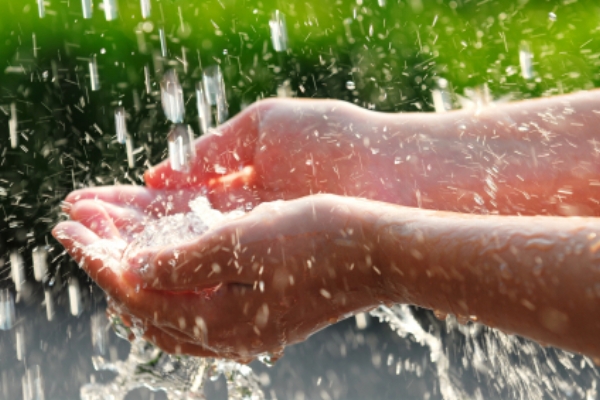Not too long ago, a woman lamented to me, “I wish I could have a rain garden, but my yard is so dry.”
“Does it ever rain at your place,” I asked.
“Well, of course,” she replied.
“Then good news! Your yard is qualified to have a rain garden!” I told her.
Let the rain kiss you. Let the rain beat upon your head with silver liquid drops. Let the rain sing you a lullaby. - Langston Hughes
This woman was like many gardeners. She had heard the term “rain garden” but wasn’t sure exactly what it meant, or if it would be something that would be appropriate for her yard. The term has become popular with gardeners who are interested in adding native plants to their landscape to absorb stormwater and help lessen the negative impact of runoff. What you may not know is that rain gardens can be as beautiful as they are functional. In fact, many of our most beautiful regional natives need the type of regular moisture found in a rain garden to thrive. Without such a moist site, a gardener would not be able to enjoy their bright, ample blooms or lush foliage. An added bonus is that most of these wildflowers attract butterflies and hummingbirds.
The moist soil of a rain garden supports vigorous growth from large-flowered, deep-rooted native plants like Joe-Pye Weed (Eupatorium maculatum), Rose Mallow (Hibiscus lasiocarpus) and Queen of the Prairie (Filipendula rubra ). Unusual wildflowers including snapdragon-like Rose Turtlehead (Chelone obliqua), elegant Blue Lobelia (Lobelia siphilitica) and the frothy plumed Goat’s Beard (Aruncus dioicus) are just a few more natives to consider. Natural selections from regional natives will also work well.
If you decide to add a rain garden to your landscape, it can be done as a weekend project. First, you’ll have to do some planning and figuring.
To establish the size of your rain garden, calculate the square footage of the area where rain will fall and runoff. For a home, figure the square footage of the home, not that of the roof. The roof pitch doesn’t change the amount of rain that falls on your home. Take that square footage, divide by the number of downspouts and then divide by 3 for the square footage of an optimum-sized rain garden on well-drained sites with sandy, loamy soils. For example, let’s take a 1728 square-foot home with four downspouts. To plan a rain garden for one downspout, divide 1728 (the square footage) by four (the number of downspouts) and then by 3 to discover you should have a 144 square foot rain garden to treat the stormwater from one downspout. To calculate the number of plants planted on 18” centers, divide 144 (the square footage of this area) by 2.25 to find 64 plants. If your soil is extremely compacted or clayey, double your square footage figure and increase the size of your rain garden, OR amend your rain garden’s soil (50-60% sand, 20-30% topsoil, 20-30% compost).
Most important, create a rain garden of some size. Even if your space is limited, you can benefit from a rain garden and help improve our area’s management of stormwater. Even small rain gardens add benefit when you think of the aggregate potential in a community.
Once the size is determined, layout your garden on the downslope of your home at least 10 feet away from its foundation. Use a rope or garden hose to test different shapes for your garden’s footprint. Within the footprint of the rain garden, create a slight depression by excavating three to five inches of soil. This also helps by removing existing vegetation. Mound this soil in a shallow berm on the downside of the garden. If your soil is extremely compacted or clayey, tilling a mixture of sand and peat into the soil will help improve the rain garden’s absorption until the native plants mature.
Arrange your rain garden plants. Group your plants with height, color and seasonal bloom in mind. Don't overlook moisture-loving woody shrubs and small trees; in addition to their absorptive contributions, they offer year-round structure.
During the first season, woodchip or gravel mulch will help prevent weeds during garden establishment. A quick weeding may be needed once a month and removing spent flowers will help prolong blooming. If your garden does not receive about one inch of water per week during the growing season, supplemental watering may be needed to keep plants blooming. Fertilization is not necessary; however, use of a slow-release fertilizer or root stimulator at planting will reduce planting shock and increase plant vigor.
To encourage new growth, do a late fall cleanup. Cut back plants to six inches tall and remove dead vegetation. After several seasons, you may divide large clumps and create additional gardens.
That’s it! As you begin planning, here are a few basics to keep in mind:
- Think bold. Moisture-loving plants will grow taller and more robustly than their dry-site counterparts so allow for plants to grow up, fill out and have room. These vivacious plants look out-of-scale in smaller gardens, but their scale works well with rain gardens that typically are 70 square feet in size or larger.
- Don’t forget your greens. Native grasses, rushes, and sedges provide textural contrast with large-leaved plants as well as year-round interest.
- Plan for change. You can get extra zip from any garden design by planning for a change of color scheme. A pastel spring palette of rain garden bloomers like Goat’s Beard, Marsh Milkweed (Asclepias incarnata) and Blue Flag (Iris versicolor) will give way to a stronger fall color scheme of violet, red and gold with New England Aster (Aster novae-angliae), Sweet Coneflower (Rudbeckia subtomentosa), Cardinal Flower (Lobelia cardinalis) and Riddell’s Goldenrod (Solidago riddellii).
If you’re not sure about how to select plants, or how to design, site and install your rain garden, don’t worry. You can always contact Bluestem for ideas on your rain garden design, installation, and maintenance. Our specialists can provide anything from general site recommendations to a unique rain garden design and complete installation---or give you something in between.
Interested in working together? We'd love to talk with you! Email us @ BluestemServices@gmail.com, or just give us a call at 573.230.1196.
Sustainable plantings, like rain gardens, offer wonderful opportunities to engage your family with nature.



